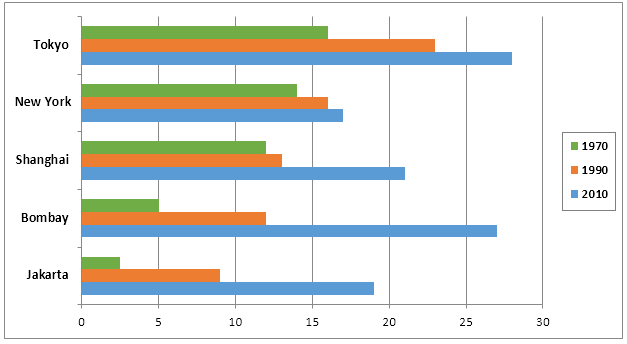IELTS graph 267 - Growth in the population in largest cities
- Details
- Last Updated: Wednesday, 04 May 2022 21:45
- Written by IELTS Mentor
- Hits: 160843
IELTS Academic Writing Task 1/ Graph Writing - Bar Chart + Table + Line Graph:
» You should spend about 20 minutes on this task.
The charts below show the growth in the population in some of the world’s largest cities as well as the population distribution in urban and rural areas.
Summarize the information by selecting and reporting the main features, and make comparisons where relevant.
You should write at least 150 words.
Population in millions

Top 5 biggest cities by population (millions)

World population in billions

Sample Answer 1:
The bar graph compares the population in five metropolitan areas during 1970 and 2010 while the table outlines the top five cities with the highest population. Finally, the line graph compares urban and rural population distribution from 1980 to 2010.
Generally speaking, the population growth in Bombay and Jakarta was faster than that of other cities and Tokyo had the highest residents in 2010. Moreover, a higher number of people started living in urban areas than in rural areas after 2005.
According to the bar graph, more than 15 million people lived in Tokyo in 1970 and that was higher than that of New York and Shanghai. Population in Bombay was one-third than that of Tokyo and Jakarta had only 2.5 million residents, the least among the five cities. The population in Tokyo increased to 27.6 million in 2010 and this was the city with the highest population. However, population growth in Bombay and Jakarta, almost 5.5 times, was higher than any other city listed.
The table data shows that New York was the most populous city in the world in 1950 with exactly 12.5 million people. London and Tokyo stood at the second and third position in this list while Moscow with its 5.3 million people was in 5th position. In 2010, Tokyo topped the rank followed by Bombay and Lagos.
Finally, globally 3 billion people lived in rural areas in 1980 while less than 2 billion in cities. In 2010, the number of city-living-residents upsurged to over 4 billion while it was slightly over 3 in villages.
Model Answer 2:
The bar graph compares the population growth in five large cities between 1970 and 2010 while the table lists down the five most populous cities in the world both in 1950 and 2010. In addition, the line graph analyses the global population in rural and urban areas.
Overall, Tokyo had the largest population in 2010 but the population growth in Bombay and Jakarta outranked other cities. Finally, more people started to live in cities after 2005 despite a different scenario in earlier years.
As the data suggests, Tokyo had over 15 million residents in 1970 which was three and five times higher than that of Bombay and Jakarta respectively. New York and Shanghai had approximately 14 and 12 million inhabitants in this year. After two decades, New York witnessed a meagre population growth while it was dramatic both in Jakarta and Bombay. It is evident that population growth in Jakarta and Bombay exceeded all other cities.
In 1950, New York, London, Tokyo, Paris and Moskow were the top five populous cities in the world. In 2010 Bombay, Lagos, Shanghai and Jakarta ranked in the list by eliminating all other cites except Tokyo which stood first on the chart with over 27 million citizens.
Finally, the global urban population in 1980 was below 2 billion while 3 billion lived in villages. The population in cities grew steadily and went over 4 billion in 2010 at which point 3 billion global population resided in rural areas.

Population growth in Bombay and Jakarta, almost 5.5 times, was higher than any other city listed. It's because, from the data, Jakarta has the least number, which is 20.8.
Overall, Bombay and Jakarta witnessed the fastest population growth, whereas Tokyo withstood the top rank for the most populous cities in 2010. Moreover, urban areas became more populated than rural areas after 2005.
In 1970, Tokyo had the highest residents, nearly 16 million, as opposed to Jakarta with less than 3 million. The population growth by 1990 was relatively the same in some cities; however, it was notoriously higher in Bombay. In 2010, although Shanghai and Jakarta experienced a rapid increase in population, about 22 and 19 million respectively, the most significant upsurge occurred in Bombay, with over 25 million residents. In 1950, New York occupied the first position, in terms of population, with 12.5 million while Moscow stood at fifth. But In 2010, Tokyo ranked highest with 27.6 citizens, followed by Bombay and Lagos, 26.6, 23.9 million people consecutively. Between 1980 and 1990, the major concentration of population was in rural areas, 3 billions of city people in contrast with 2 billion in urban areas. In 2010, 4 billion people had been living in cities compared to a billion fewer in villages.
Report